Department Environmental Microbiology
Biological diversity at the level of individual bacterial cells
Microbial communities play a key role in many natural environments. Such communities drive many of the key processes in the cycling of elements on the planet, and engage in interactions that affect health and disease of humans, animals and plants. We investigate the behavior of individual bacterial cells in such communities. We use modern optical and analytical methods to identify the genetic programs that are expressed in individual bacteria, and to determine how these genetic programs determine behavior, metabolism and survival of individuals. We find a large degree of individuality at the level of single cells. Genetically identical bacterial cells that reside in the same environment show a marked degree of variation – individual cells specialize on different activities, engage in the division of labor, and can achieve new functionality as a group of individuals with different traits.
Phenotypic variation between genetically identical bacterial cells. Salmonella bacteria produce a toxin that kills other bacteria. Not all individual in a family of genetically identical bacterial cells engage in toxin production. Left: Microscopy image of a family of genetically identical Salmonella bacterial. Bright colors mark individual cells that produce toxin. Right: Image analysis of this family. The family grew in five hours from a single cell through cell division. The variation in behavior between cells emerged within these five hours. Image and Analysis: Simon van Vliet.

